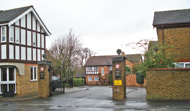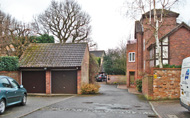General
The first hospital in Wimbledon was built
opposite the Atkinson Morley's Hospital,
a convalescent home for patients from St
George's Hospital, which had been
completed in 1869.
The Wimbledon Cottage Hospital opened in 1870 with 8 beds.
The
Chancery barrister, Edward Thurstan Holland, was one of its founders
and its first Honorary Secretary and Treasurer (Thurstan Road is named
after him).
By 1906 the Hospital had 18 beds. A suggestion was made in 1907 that it amalgamate with the South Wimbledon, Merton and District Cottage Hospital, but nothing came of the plan.
In 1911 the Management Committee decided that the Hospital should be completely rebuilt, at a cost of £9,500. The Hospital was closed and work began on the site, while patients were treated in temporary premises. The new building, with a central administration block and two wings, opened in 1912. It had 37 beds and 4 cots and was renamed the Wimbledon Hospital.
During WW1 it was one of the first smaller hospitals to offer treatment for sick and wounded servicemen. It became an auxiliary military hospital to the Horton War Hospital, with the first 20 casualties arriving from France in October 1914. The Hospital had given up 32 of its beds for war casualties but, in 1917, marquees were erected in the grounds to provide more bed accommodation. The military beds closed on 19th February 1919. During the war some 500 soldiers received treatment at the Hospital, of whom only one died.
In the 1920s a nurse was fatally electrocuted during a mobile X-ray examination. Having been told she was standing too close, she did not heed the warning and touched the apparatus at the moment of exposure. (Shock-proof equipment was introduced in the late 1930s).
In May 1922 Earl Haig opened the new Nurses' Home. The old nurses' quarters were converted for patient use, after which the Hospital had 60 beds.
In November 1928 a new children's wing with 12 beds was opened by Princess Arthur of Connaught. A Domestics' Home had been built at the same time.
By 1938 the Hospital had 74 beds - 18 for males, 26 for females and 18 for children, and 12 private rooms. At this time the cost of an in-patient per week was £3 11s 1d (£3.55), compared to £3 5s 7d (£3.28) in 1937. A new (shockproof) X-ray machine was installed and an appeal was launched to raise funds to modernise and extend the Massage and Electrical Treatment Departments. It was planned also to build a new female ward with 19 beds and to provide 10 more private patients rooms, as well as extending the Nurses' Home to provide new accommodation for domestic staff.
During WW2 the Hospital became part of the Emergency Medical Scheme (EMS), with 30 extra casualty beds. By 1945 it had 93 beds, including the EMS beds (but these were reduced to 15, then 10, in 1946). The cost of an in-patient had risen to £9 1s 9d (£9.09) per week, which escalated to £12 15s 6d (£12.77) in 1947.
In 1948 it joined the NHS, with 84 beds, as the Wimbledon Hospital, under the control of the St Helier Group Hospital Management Committee, part of the South West Metropolitan Regional Health Board.
In 1953, after the siting of beds had been rearranged, it had 82 beds. The weekly cost of an in-patient was £15 5s (£15.25).
In 1956 the Domestics' Home was converted into an Out-Patients Department and a Physiotherapy Department.
By 1957 some 10 of the 22 members of the medical staff also worked at the Nelson Hospital. The two Hospitals shared the same Preliminary Training School for nurses and the same Hospital Secretary, but the two House Committees were entirely separate.
Under an Act of 1871 the expenses of managing and maintaining Wimbledon Common was payable by every tenant or occupier of a dwelling house of an annual rateable value of £35 or more which stood within three-quarters of a mile from some part of the Common. The Hospital was considered a dwelling house, despite its patients being unable to enjoy the amenities of the Common and, in 1959, it was obliged to pay a charge of £20 for the year.
In 1965 the Hospital had 81 beds, of which 72 were staffed. The weekly cost of an in-patient was £51 5s 0d (£51.25), which decreased to £50 1s 3d (£50.06) in 1966.
By 1970 the weekly cost of an in-patient had risen to £73.39 and, by 1971, to £93.46.
In 1971 a new geriatric unit opened.
In 1974, following a major reorganisation of the NHS, control of the Hospital transferred to the Sutton and West Merton District Health Authority, part of the South West Thames Regional Health Authority.
In October 1981 it was decided that the Hospital should close.
Closure took place in 1983. Services moved to the Nelson Hospital,
Present status (March 2008)
The Hospital was sold in May 1984 for £1.8m. It was demolished and Grange Park Place, a modern housing development, now occupies the site.

Entrance into Grange Park Place from Thurston Road.


Looking east (left) and west (right) along Grange Park Place.
(Author unstated) 1907 North and South Wimbledon Cottage Hospitals. British Medical Journal 1 (2405), 290.
(Author unstated) 1917 List of the various hospitals treating military cases in the United Kingdom. London, H.M.S.O.
(Author unstated) 1917 News in Brief. The Red Cross 4, 84.
Ellis H 1931 Annual Report of the Medical Officer of Health. London, Borough of Wimbledon, 14.
Smith J 1984 Hospital building in the NHS. Ideas and design II: harness and nucleus. British Medical Journal (Clin Res Ed) 289, 1513.
http://rcnarchive.rcn.org.uk
https://forebears.io
https://photoarchive.merton.gov.uk
www.british-history.ac.uk
www.facebook.com
www.wimbledonguardian.co.uk
Return to home page